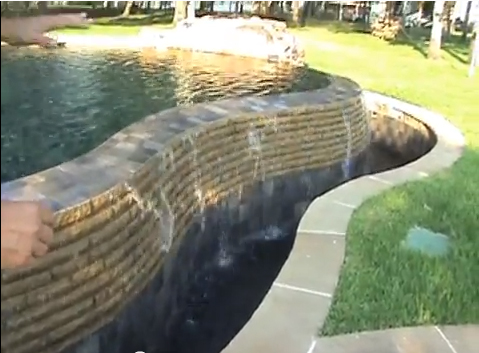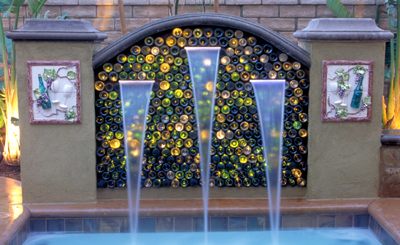materials
Of all the design innovations that have spread through the general watershaping community in the past 20 years or so, I can’t think of any that has captured consumer imaginations as dramatically as have vanishing-edge designs. They rose from minimal presence in the late 1980s to become the most recognizable and popular of all
Today’s consumers are more environmentally savvy than ever before, so it’s good that there are plenty of like-minded landscape designers and watershapers out there – “green-oriented” professionals who are more than interested in working with homeowners to create outdoor environments that are
We know that the equipment and materials they offer us stand at the core of everything we design and/or build as watershapers. Nonetheless, it’s easy to overlook the significant role played by those who manufacture, distribute and support the products we use. As I see it, however, discounting the role of suppliers in the watershaping process is a serious mistake. Not only do these companies
Among the most gratifying of all projects are those in which designers are able to forge links between different areas of a property, creating an unfolding, choreographed experience that generates notes of anticipation along with reassuring sensations of comfort and familiarity. In our work at Root Design Company (Austin, Texas), we’ve found that water is a powerful tool in defining those sorts of connections within a property, whether it is used in bold ways, as with fountains or swimming pools, or as subtler secondary or tertiary elements, including runnels or small waterspouts. In the project depicted here, we used multiple watershapes within architectural spaces that organize those settings and bring motion and continuity to the overall space. It all ties together visually, with each path leading to intriguing destinations that serve as rewarding visual experiences for anyone who visits. As we see it, the key ingredient in this project was our client, who understood
Looking beyond standard modes of operation is nothing new for watershapers: It’s how many of us grow professionally. In my case, for example, I’ve moved in a variety of different directions in my career, and I’ve found that each of these endeavors has added substance and insight to both my business and professional acumen. Some experiences are more valuable than others, of course, but I’ve always found something positive and a few times have watched my business transform and grow before my eyes. Looking back, it’s been quite a journey. I began my career more than 20 years ago with
With vast experience in both the residential and commercial markets, Kevin Ruddy is one of the watershaping industry’s foremost experts on the design and construction of indoor swimming pools and their surrounding environments. Here, in this first of two features covering a complicated residential project, he discusses the painstaking process of designing a pool and the systems that integrate it with the surrounding structure. It seems counterintuitive, but indoor swimming pool environments are wholly and entirely distinct from their outdoor cousins. The differences are mostly contained in the fact that, indoors, the designer needs to consider not only the pool and its hydraulic performance, but also the enclosure and the air-handling and dehumidification systems that makes these spaces comfortable and enjoyable for clients and their guests. Through years of designing and installing indoor pools, we at Omega Pool Structures (Toms River, N.J.) have learned – sometimes the hard way – what works and what doesn’t. Now, supported by more than two decades’ experience, we’ve
Fire effects have grown tremendously in popularity in recent years, especially among swimming pool designers and builders who use them in developing various fire-on-water features. On one level, it seems that these professionals (and their clients) have noticed that systems that contain and control fire serve as wonderful complements to systems that contain and control water. On a grander scale, however, it’s apparent that, as watershape designers and builders have become more and more creative, fire features have risen in the estimation of those who want to give their clients something special – something few others have. At my company, Grand Effects of Irvine, Calif., we’ve focused on making it easy for watershapers, general contractors and landscape designers and architects to bring fire into the picture across a range of applications. To that end, we’ve developed an array of completely off-the-shelf systems, ready to install, and have done all of the engineering and testing required to build confidence into every product. In doing so, we’ve studied possible effects and developed
Boston’s Big Dig was essentially a Big Fix. Officially known as the Central Artery Tunnel Project, it served to repair damage done to the heart of the city by the Interstate Highway program during the 1950s and ’60s. In Boston’s case, the federal government had stepped in and inserted a primary traffic artery through what had been a downtrodden area near the waterfront. Its intentions may have been good, but I-93 ran north to south and separated the city’s historic downtown area from its storied waterfront – a disastrous decision that did little more than create decades’ worth of traffic nightmares. Ultimately, it also required remediation on a scale seldom seen in the course of human history. Planning for the project began in 1982, initiating what would become
Not long ago, I did a pair of columns on healing gardens and their benefits. If you’ll recall, I preached the importance of persuading hospitals in particular to include these spaces in their overall site plans as a means of providing garden environments for patients, patients’ families and hospital staff: These spaces reduce stress, help patients heal more quickly and give everyone who visits them a soothing sense of tranquility. I’ve attempted to the greatest extent possible to practice what I preached, and through the years I’ve installed numerous health-specific gardens at local assisted-living centers, Alzheimer’s care facilities and even at a center for emotionally-challenged children. But truth be told, I haven’t met with much success with our local hospitals, despite the fact that healing gardens have caught on with countless such facilities coast to coast. I don’t know quite why this is, but we





















